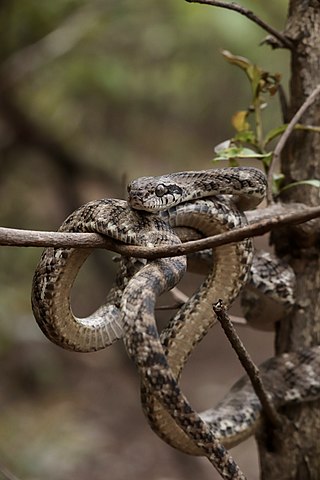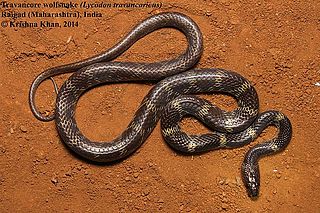
Bronchocela cristatella, also known as the green crested lizard, is a species of agamid lizard endemic to Southeast Asia.

Agasthyagama beddomii, commonly known as the Indian kangaroo lizard, is a diurnal, terrestrial, insectivorous agamid lizard, endemic to the Western Ghats of South India.
Trimeresurus cantori, commonly known as Cantor's pit viper or Cantor's pitviper, is a species of venomous snake, a pit viper in the Subfamily Crotalinae of the family Viperidae. The species is endemic to the Nicobar Islands of India. It was named after Theodore Edward Cantor (1809-1860), a Danish naturalist serving as a surgeon with the East India Company in Calcutta. No subspecies are recognized as being valid.
The Yunnan keelback is a species of natricine snake which is endemic to Asia.
The Assam keelback, commonly known as Peal's keelback, is a species of snake in the subfamily Natricinae of the family Colubridae. The species is endemic to Northeast India. It has recently been rediscovered after 129 years in Arunachal Pradesh.

The Himalayan keelback is a species of grass snake in the family Colubridae. The species is endemic to South Asia.

Boiga forsteni, also known commonly as Forsten's cat snake, is a species of mildly venomous rear-fanged snake in the family Colubridae. The species is endemic to South Asia.

Boiga trigonata, commonly known as the Indian gamma snake or common cat snake, is a species of rear-fanged colubrid endemic to South Asia.

Lycodon travancoricus, commonly known as the Travancore wolf snake, is a species of colubrid snake endemic to south India.

Sibynophis sagittarius, commonly known as Cantor's black-headed snake after Theodore Cantor, is a species of snake endemic to South Asia.
Trachischium guentheri, commonly known as the rosebelly worm-eating snake or Günther's worm-eating snake, is a species of colubrid snake, which is endemic to Asia.
The mountain worm-eating snake is a species of colubrid snake.

Trachischium tenuiceps, also known as the yellowbelly worm-eating snake, is a species of colubrid snake found in South Asia and Tibet.

Calliophis nigriscens, commonly known as the black coral snake or striped coral snake, is a species of venomous elapid snake endemic to the Western Ghats, India.

Eryx conicus, also known as Russell's boa, the rough-scaled sand boa or the rough-tailed sand boa, is a species of non-venomous snake in the subfamily Erycinae of the family Boidae. The species is native to Southern Asia. No subspecies are recognised.

Ophisops leschenaultii, commonly called Leschenault's snake-eye, Leschenault’s lacerta, or Leschenault's cabrita, is a species of lacertid lizard endemic to India and eastern Sri Lanka. In Sri Lanka, this lizard is called Pandura katussa in Sinhala. In some parts of the country, it is also called Heeraluwa or sikanala, which is more common name for all skink-like reptiles.

Trachischium is a genus of snakes, known commonly as slender snakes or worm-eating snakes, in the subfamily Natricinae of the family Colubridae. The genus is endemic to Asia.
Eryx elegans is a boa species endemic to western Central Asia. Like all other boas, it is not venomous. No subspecies are recognized.

The Seychelles wolf snake is a species of snake in the superfamily Colubroidea. It is monotypic within the genus Lycognathophis. The New Latin name, Lycognathophis, is derived from the Greek words λύκος (lykos) meaning "wolf", γνάθος (gnathos) meaning "jaw", and όφις (ophis) meaning "snake", referring to the snake's dentition.
Aspidura copei, commonly known as Cope's rough-sided snake or කලු මැඩිල්ලා in Sinhalese, is a species of snake in the family Colubridae. The species is endemic to Sri Lanka.












